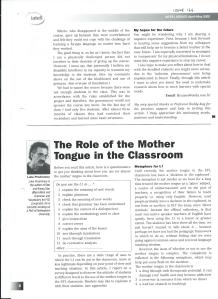For many years, the discourse (but not necessarily the practice) of English language teaching was dominated by UK-based private language schools (e.g. the British Council, International House), the teacher training courses (e.g. CELTA) they ran, the coursebooks their teachers and ex-teachers wrote, and the university departments that they maintained close links with. Even now, take any well-known ELT writer and the odds are they have very close connections with this world. The context of this world is multilingual and therefore problematic for translation practices. These institutions are also closely connected to the nexus of private language schools around the world, often staffed with large numbers of native-speaker teachers (who are not necessarily competent in the students’ own languages), that market themselves as different from the traditional grammar-translation approaches of state school teachers.
This dominance is beginning to shift, however. With a massive growth in English language teaching provision around the world and with a growing awareness of the global nature of English as a lingua franca, native-speakers are starting to lose their authority over both the language and methodologies for teaching it. The experiential knowledge base has shifted, with an unsurprising refocussing of interest on translation.
Widdowson (2003, p.160) and others have argued that the neglect of translation has little to do with any considered pedagogic principles. As scholars have turned to the pedagogic principles, they have discovered that there is ‘an array of recent evidence and argument in favour of reincorporating students’ own languages into language teaching, and a corresponding disquiet that they were ever excluded’ (Cook, p.51). Strict English-only learning environments may actually be detrimental (Turnbull & Dailey-O’Cain, p. 186)! Why? For the simple reason, as Costas Gabrielatos succinctly puts it, that ‘new knowledge (e.g. of the L2) is constructed on the basis of existing knowledge (e.g. of the L1)’. Prohibiting L1 is to deprive learners of their most valuable resource.
It has often been suggested that the use of translation techniques in language learning can lead to negative transfer from the L1. Researchers are now suggesting that, when used appropriately, translation can actually ‘counteract learners’ tendencies to transfer structures from their mother tongue’ (H. Zojer in Witte et al, p.38)
- Intercultural and Humanist
With the growing interest in intercultural aspects of language learning has come an awareness that the business of translating between languages and cultures must assume ‘a central place of relevance for anyone involved in the complex project of interculturality, including, and foremost, foreign language learners.’ (Witte et al, p.6-7) What’s more, ‘referencing the learners’ L1 validates their linguistic and cultural identity, while proscribing it might be considered a form of linguistic imperialism’ (Gabrielatos).
We also know that the more a learner believes in their possibility of success in the language learning enterprise, the more successful they are likely to be. If teachers attempt to ban one of most learners’ preferred learning strategies (i.e. translation), they are unlikely to be doing much good for the learner’s confidence. Judicious use of L1 may also reduce anxiety … so important for lower-level learners.
A final point worth making here is that it is generally agreed that it is important that learners can express personal meanings in the classroom. Bolitho (1983, quoted by Atkinson, p.242) points out that ‘an important role of the mother tongue is to allow students to say what they really want to say sometimes (surely a valuable ‘humanistic’ element in the classroom). Clearly, once it is established what the learners want to say, the teacher can then encourage them to find a way of expressing their meaning in English or, if necessary, help out.’
Online translation technologies (e.g. Google Translate) and apps for handheld devices have radically transformed the world for anyone involved in negotiating meaning in another language. Our students will use these technologies, whether we like it or not. We need to help them make use of these resources critically and intelligently.
‘Translation is one of the most authentic activites imaginable as it is done constantly in ‘real’ life – outside the classroom – and in many cases is the only activity connected with the foreign language that our students will be involved in later on.’ (Grellet, p.11)
Translation can also be the most time-efficient way of dealing with some classroom problems (e.g. false friends); it requires little or no preparation … and let’s be honest – the recommendation that foreign-language classes be taught exclusively in the foreign language remains ‘aspirational in [many] real life classroom situations, especially if the class in question is still at the beginning of its long path to linguistic perfection, or where the level of target language required to follow instructions is not as yet adequate’ (Zojer in Witte et al, p.36).
Conclusion
There is a very strong research-based consensus that the use of L1 and translation in foreign language classrooms has much to offer. The onus of responsibility now rests with those who continue to argue the contrary to support their arguments with more than anecdotes, hunches and feelings.
Addendum
Going through my files today, I found a copy of an article from 2002 by Luke Prodromou. Since it may not be easy to find in libraries, I thought I would put it up here.








